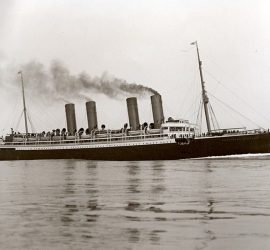1901 – 1928 / White Star Line’s second Celtic was the first of the company’s ‘Big Four’ quartet and the world’s largest ship thus far. Having served in World War I, she ran aground in 1928 and was declared a total loss.
world war I
1901 – 1923 / A true German greyhound, the Kronprinz Wilhelm was one of the fastest ships of her time. Serving as an armed merchant cruiser in World War I, she spent eight successful months as a raider. Seized by the US in 1917, she served as a troopship and was sent to the breakers a few years after the armistice.
1903 – 1932 / As the second vessel of White Star Line’s ‘Big Four’ quartet, the Cedric saw a successful career which included wartime service as an armed merchant cruiser.
1903 – 1940 / The Kaiser Wilhelm II managed to set a new record for an eastbound crossing of the North Atlantic, but was interned in the US at the outbreak of World War I. Eventually seized and used as an allied troopship, the ship then languished for almost 20 years after the war, and was in the end sent to the breakers.
1904 – 1933 / Third in White Star’s ‘Big Four’ quartet, the second Baltic was launched as the world’s largest ship. She had a long career as a popular vessel, and served as a troop transport during World War I. She ended her days at the shipbreakers in Japan.
1905 – 1932 / Cunard’s first Caronia was the company’s hitherto largest ship, although no record-breaker in terms of speed. Her career was prosperous, and she served in World War I both as an armed merchant cruiser and a troopship. Her end came at the shipbreakers in Osaka.
1905 – 1957 / Also known as America (I) / A German competitor in terms of size and luxury, the Amerika was seized and used as an allied troop transport during World War I. Her post-war career was under the American flag, but as her age caught up with her, she was finally sent to the breakers.
1905 – 1932 / Partially an experimental ship, the Carmania was fitted with turbines to test their feasibility. While never a record-breaker herself, she paved the way for the famous greyhounds Lusitania and Mauretania.
1907 – 1940 / The last of the German ‘Four Flyers’, the career of Kronprinzessin Cecilie ended when she was confiscated by the US for military use in World War I. Afterwards, she languished in Chesapeake Bay for almost 20 years before being scrapped.










